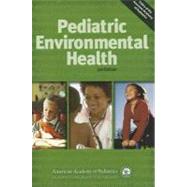Pediatric Environmental Health
, by American Academy of Pediatrics Council on Environmental Health; Etzel, Ruth A., M.D., Ph.D.; Balk, Sophie J., M.D.- ISBN: 9781581103137 | 1581103131
- Cover: Paperback
- Copyright: 10/28/2011
Completely revised and expanded, the new 3rd edition is the comprehensive AAP guide to the identification, prevention, and treatment of pediatric environmental health problems. From playground to classroom, at home and across town, environmental hazards are all around us an unfortunate fact of modern life. And no one is more vulnerable to the adverse health effects these hazards can cause than our children. It's no wonder that environmental hazards are among parents' top health concerns for their children. Yet little time is spent training physicians and other caregivers to recognize, prevent, and treat ailments resulting from exposure to harmful substances and environments. This comprehensive guide puts critical children's health information and answers to parents' questions at your fingertips. From asbestos to radiation, ultraviolet rays, pesticides, asthma, lead, tobacco, childcare and school environments plus new chapters on global climate change, plasticizers, developmental disabilities, environmental disasters, and more current information on an exhaustive range of environmental health issues is included. The 3rd edition features 59 topic-based chapters including the addition of 18 new chapters. Contents: - Background: Addressing Environmental Health in Primary Care - History and Growth of Pediatric Environmental Health - Children''s Unique Vulnerabilities to Environmental Hazards - Individual Susceptibility to Environmental Toxicants - Taking an Environmental History and Giving Anticipatory Guidance - Medical Laboratory Testing of Body Fluids and Tissues - Environmental Measurements Environments - Preconceptional and Prenatal Exposures - Built Environment - Child Care Settings - Schools - Waste Sites - Work Places - Environmental Health Considerations for Children in Developing Nations, and Implications for Immigrants and Adoptees Food andWater - Breast Milk - Phytoestrogen and Contaminants in Infant Formula - Water - Food Safety - Herbs, Dietary Supplements and Other Remedies Chemical and Physical Exposures - Air Pollutants, Indoor - Air Pollutants, Outdoor - Arsenic - Asbestos - Carbon Monoxide - Chromium, Manganese, and Nickel - Cold and Heat - Electric and Magnetic Fields - Endocrine Disrupters - Gasoline and its Additives - Ionizing Radiation (Excluding Radon) - Lead - Mercury - Nitrates and Nitrites in Water - Noise - Persistent Organic Pollutants - DDT, PCBs, PCDFs, and Dioxins - Persistent Toxic Substances - Pesticides - Plasticizers - Radon - Tobacco Use and Secondhand Tobacco Smoke Exposure - Ultraviolet Radiation SpecialTopics - Arts and Crafts - Asthma - Birth Defects and Other Adverse Developmental Outcomes - Cancer - Chelation for "Heavy Metal" Toxicity - Chemical-Biological Terrorism - Developmental Disabilities - Drug (Methamphetamine) Laboratories - Emerging Technologies and Materials - Environmental Disasters - Environmental Equity - Ethical Issues - Global Climate Change - Multiple Chemical Sensitivities - Nontherapeutic Use of Antibiotics in Animal Agriculture Public Health Aspects of Environmental Health - Precautionary Principle - Risk Assessment, Risk Management, and Risk Communication - Environmental Health Advocacy







